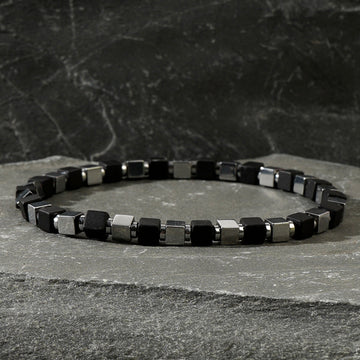The cultural implications and symbolic meanings of men wearing stone bracelets integrate multiple connotations such as natural philosophy, social status, spiritual beliefs, and modern personality expression, which are specifically manifested as follows:
First, the visualization and protection of natural forces
Energy absorption and purification
Obsidian is regarded as the "eye of the volcano", symbolizing the absorption of negative energy and the resistance to evil spirits. Ancient warriors often wore it to pray for peace on the battlefield. Lapis lazuli, due to its color being close to the starry sky, is believed to connect the celestial realm, and the wearer thereby gains wisdom and guidance. The natural properties of these stones are endowed with supernatural powers and become a medium for communication between humans and nature.
A symbol of courage and strength
Tiger's eye stone has a texture similar to a tiger's eye, symbolizing the spirit of fierce beasts. Ancient nomadic people regarded it as a carrier of courage. Turquoise in Tibetan Buddhism represents the sky and the ocean, symbolizing purity and eternity. It is often used to decorate ritual implements and enhance the spiritual strength of the wearer.
Second, the identification of social status and identity
A symbol of power and authority
Agate was used by pharaohs in ancient Egypt for crown decoration, symbolizing ruling authority. Officials in the Han Dynasty of China wore jade bracelets to show their status. Hetian jade, as a symbol of "a gentleman compares his virtue to jade" in Confucian culture, became a moral symbol for the scholastic class, and thus stone bracelets became an external expression of status.
The division of wealth and class
In medieval Europe, amber (beeswax) bracelets were exclusive to the nobility, and wearing them by commoners might be regarded as transgressivity. In African tribes, ivory bracelets symbolize the authority of the chief and can only be obtained through war or rituals. The scarcity of stone and the complexity of its craftsmanship are directly related to the social status of the wearer.
Third, spiritual belief and the carrier of spiritual practice
The core props of religious ceremonies
In Tibetan Buddhism, the Tianzhu (etched agate) bracelet is engraved with six-character mantra or auspicious totems and is a ritual implements for Esoteric practitioners. The Hindu sacred stone "Rudraksha" (obsidian) is regarded as the tear of Shiva, and believers wear it to obtain the protection of the deity. Stone bracelets have become a physical bond connecting people with religious beliefs.
A metaphor for Zen and self-cultivation
In the Japanese tea ceremony, the pattern of the bamboo joint stone bracelet symbolizes the Zen meaning of "Ichigo Ichie", reminding the wearer to cultivate their mind. The minimalist design of the plain ring bracelet without patterns aligns with the Taoist philosophy of "the greatest truth is the simplest", pursuing inner peace. The natural properties of stone are endowed with the symbolic meaning of spiritual cultivation.
Fourth, the expression of individuality in modern culture
The rebellious symbol of subculture
In punk style, bracelets combining rivets, metals and obsidian symbolize rebellion and freedom, and rock singers often wear such designs. In the aesthetics of vaporwave, neon-colored resin bracelets imitate the natural stone patterns, reflecting the deconstruction of nature and technology by postmodern culture. Stone bracelets have become the visual language for subcultural groups to express their attitudes.
A declaration of environmental protection and naturalism
Recycled stone bracelets are made by pressing waste glass or mineral powder, through which wearers express their support for sustainable development. The handcrafted raw stone retains the natural cracks and textures of the ore, emphasizing the "beauty of imperfection", which aligns with the contemporary aesthetic that "flaws are individuality". The sustainability and natural attributes of stone have been endowed with modern values.
Fifth, special implications in different cultures
The sacrificial medium of the Mayan civilization
The obsidian bracelets unearthed at the Palenque site are engraved with calendar symbols and were used for rituals and divination to connect the living with the deceased.
A symbol of purity in Islamic culture
Lapis lazuli and coral symbolize purity and sanctity in Islamic culture. Men often wear lapis lazuli belt buckles instead of traditional bracelets.
The spiritual inheritance of the Maori tribe
Green jade (Pounamu) is the "Hei-tiki" totem of Maori warriors, which is only worn by male members of the family. After being transformed into a bracelet, it continues the tribal spirit.
When men wear stone bracelets, it is not only a concrete expression of natural forces, social status and spiritual beliefs, but also a carrier of modern personality and cultural identity. Its cultural connotation has evolved with The Times, gradually transforming from sacred props in religious ceremonies into visual declarations of personal style and values.







